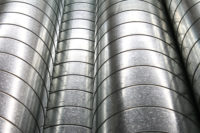Construction Materials Prices Flatten in September
The amount contractors pay for a range of key construction materials held steady in September but climbed 8.1% from the year-earlier level, according to an analysis of producer price index figures released last week by the Associated General Contractors of America. Meanwhile, the price contractors charge for new nonresidential building construction edged up only 2% to 3% over 12 months, depending on building type.
“Feeble demand for construction is forcing contractors to absorb the bulk of materials price hikes, instead of passing them along to owners,” said Ken Simonson, the association’s chief economist. “This pattern has persisted for more than two years, and many contractors are increasingly at risk of going under.”
Simonson noted that key materials showed divergent price trends in September but all posted double-digit year-over-year increases. Those materials include diesel fuel, up 3.3% for the month and 39.4% since September 2010; copper and brass mills shapes, down 0.7% in September but up 14.8% over 12 months; steel mill products, which slipped 0.6% for the month but rose 13.5% for the year; and aluminum mill shapes, down 1.8% for the month but up 10.4% from a year earlier.
“These prices can spike anytime there is a global supply disruption or a consensus that demand is strengthening worldwide, not just from U.S. construction,” Simonson explained. “In contrast, materials produced here and used only by U.S. construction have shown little price movement.”
He cited, as examples, the producer price indexes for concrete products, up 0.2% in September and 0.3% over 12 months; lumber and plywood, down 1.3% for the month and 0.4% for the year; and gypsum products such as wallboard, down 1.7% and 4.6%, respectively.
Simonson observed that the price index for new construction—what contractors charge for construction projects—rose 2.2% over 12 months for industrial buildings, 2.6% for offices, 2.8% for warehouses and 3.0% for schools. “In light of the much steeper materials cost increases, these gains are not enough to keep contractors solvent,” he warned.
Association officials said that in addition to the cost squeeze, the construction industry was suffering from decreasing demand for public sector construction activity. They said that while state and local construction budgets will continue to contract for the foreseeable future, Washington could help offset some of the decline by enacting legislation to make needed, long-term, investments in highways, transit systems, clean water systems, airports and runways.
“Given the stagnant construction bid prices, taxpayers stand to benefit if Washington acts quickly to enact new infrastructure investments,” Stephen E. Sandherr. “Even if construction prices rebound in the near future, it is still a lot less expensive to maintain infrastructure while it is operating than to fix it once it breaks.”




